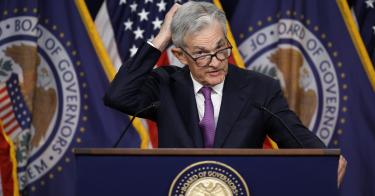The Federal Reserve’s rapid interest rate hikes over the last year have caused credit to become more expensive for consumers and businesses. The monthly mortgage payment on a median price home has more than doubled since January 2021 and credit-card interest rates are at a record high.
Worse, the economy is stuck with these high interest rates because the government can’t control its spending.
Interest rates are the price for borrowing money and, like all prices, they’re determined by supply and demand. The supply of loanable funds is provided by savers and the demand is generated by borrowers. Interest rates will rise if there is either a decrease in savings or an increase in borrowing. And the Treasury Department has increased its borrowing in spades.
Because of runaway spending by Congress and the White House, the federal deficit has exploded. Consequently, the Treasury borrowed $2.8 trillion and $1.4 trillion in fiscal years 2021 and 2022, respectively. The current fiscal year’s deficit is estimated to come in well over $1.5 trillion with next fiscal year’s estimate increasing yet again.
It’s no wonder the federal debt is now over $33 trillion.
>>> How Washington’s $7.5 Trillion Deficit Spending Spree Is Bankrupting America
In short, the Treasury is crowding out the loanable funds market, and that’s pushing interest rates through the roof. However, for more than a year after President Joe Biden took office, the Fed kept rates at zero. While that meant the Treasury could borrow very cheaply, it also caused inflation.
Since then, the Fed has been raising interest rates to reduce inflation, but that has drastically increased borrowing costs for the Treasury. To minimize the financial pain for the federal government, the Fed also began manipulating financial markets to transfer borrowing costs from the Treasury to the private sector. That means the Treasury pays relatively less interest while consumers and businesses pay more.
But the Treasury has borrowed so much to cover its multi-trillion-dollar deficits that it has overpowered even the Fed’s ability to control interest rates. That, in turn, has caused the Treasury’s borrowing costs to rise at the fastest pace ever.
Gross interest on the federal debt is now the third biggest line item in the Fiscal Service’s monthly Treasury report, behind only the Social Security Administration and the Department of Health and Human Services.
The Treasury has already spent $808 billion on interest in the first 11 months of this fiscal year, 19% more than the first 11 months of the previous fiscal year. And it’s going to get much worse, very quickly.
Over the next 12 months, the Treasury will borrow about $2 trillion to cover the federal deficit while about $8 trillion of existing debt matures, at which point the Treasury will have to repay what it previously borrowed.
>>> Why U.S. Is Staring Down the Barrel of Another Recession
Because the government is running such a massive deficit, however, there’s no money left to pay back what was previously borrowed, so the Treasury just rolls over the debt, borrowing more money to pay off the old loans.
It’s like when a person maxes out a credit card and then can’t repay the balance when it’s due. Instead of taking responsible steps to cut personal spending, the person can simply get a new card and transfer the balance. That’s what the Treasury is doing, but with trillions of dollars at a time.
The problem here is that when debt is rolled over, it is subject to today’s interest rates, regardless of what the interest rate was on the old debt. The nearly $8 trillion of debt that the Treasury must roll over will change from interest rates around 2% to over 5%, more than doubling the finance charges on that debt.
The Treasury will have to issue almost $10 trillion in debt over the next 12 months, at interest rates around 5%. Annual interest costs on just this portion of the federal debt—less than one-third of the total debt—will be about $500 billion.
Higher interest rates mean heavier borrowing costs for consumers, businesses and the Treasury alike. But if the Fed relents on its campaign of interest rate hikes, then inflation will get worse. For inflation and interest rates to both come down, the cause of both problems must be reduced: government deficit spending.
Until that happens, higher interest rates are here to stay.
This piece originally appeared in MSN




